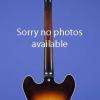"A New Legend In The Making"
This is an all original 18 watt black-face (with silver-sparkle grille cloth) Super Champ tube combo that weighs just 25 lbs. The cabinet which is covered in the original black tolex measures 17 inches wide x 14 1/4 inches high. The depth of the cabinet is 6 1/2 inches at the top expanding to 8 1/4 inches at the bottom. One original ten-inch Fender "Special Design" Speaker with a stamped code on the cone: "506111-2". Control panel with single instrument input, one "Volume" control (with "Pull for Lead" switching), one "Treble" control (with "Pull for Mid" switching), one "Bass" control, one "Reverb" control, one "Lead level" control and one "Master" volume control. The serial number "F3 13555" is stamped onto the chassis. The black tolex covering and the silver sparkle grille cloth are almost as new and the original black plastic handle has virtually no wear. A wonderful little thirty-six-year old legend in the making… just turn it up for real tube gain at a reasonable volume.
"A fancier version, the Super Champ, included reverb and a hot-rod lead channel. "A new legend in the making!" was the company's prediction, and it has held true, as this short-lived variant almost immediately became sought after by those looking for a very small, loud, full-featured amp with good tone." (Teagle & Sprung. Fender Amps. The First Fifty Years. p. 68).
"The now collectible, 18W, 1 x 10 Super Champ was one of Fender's most noteworthy success stories from 1982 to 1986. This 2x6V6 powerhouse featured a three-spring Accutronics reverb, plenty of volume, and a high-gain circuit, all in a compact package. Paul Rivera: "The Super Champ became almost a cult amplifier, selling something like 7,000 or 8,000 a year. It epitomized the idea of the pocket rocket, a killer sound in a tiny package. Today they're just about worshipped, and cost a fortune on eBay."
"The Paul Rivera-designed Super Champ is the most fun amp I know of! It's the lightest, most amazing sounding amp ever made. Not only is it great for playing at low volumes at home (terrific for rehearsals) and in the studio, but it is one of the best recording amps ever. Put a microphone in front of it and you'll discover some of the biggest clean and dirty sounds of all time. Most great amps are fun a lot of the time, but the Super Champ is the only amp I know that is fun all of the time." - Henry Kaiser
"The greatest amp I've ever owned is a little Fender Super Champ with the stock ender speaker, not the Electro-Voice." - Robert Quine (all quotes taken from Tom Wheeler. The Soul of Tone. pp. 482-483).
"In 1981, CBS decided it was time for new management at Fender... Roger Balmer... looked around for someone to inject new life into the amplifier line and approached a man called Paul Rivera, who had a long and fascinating history as an amplifier designer/guru - and little experience of corporate life. Like so many others in the Fender amplifier story, including Leo and Don Randall, Rivera had been a ham radio enthusiast... playing guitar and mending friends' amplifiers, and working for a while as an apprentice at Ampeg, Rivera acquired enough expertise to open his own custom amp shop in San Diego, California, building massively powerful Fender copies for bass players and modifying Marshalls. Later he designed solid-state amplifiers for Yamaha and even built and sold a few MESA Boogies. In January 1981, he was hired by Fender, secretly, before joining officially in May. 'They hired me as director of marketing for amplifiers, to get them back into the amp business,' he says, 'because at that time they had a very small line of basically the same products they'd had since time began. They didn't have... anything that was really competitive in the market. They couldn't give the damn things away. Their sales were down to about 10,000 units a year, and for Fender that was like they were out of the amp market. It was expensive tube stuff that didn't even sound modern. Where was our Marshall killer? Where was the amp that the guy could go into a club and cut a date that had some popular sounds on it?' The amps he now introduced were modeled on the customized combos he had produced in the past, incorporating multiple volume controls and channel switching. 'One of them, which was one from my childhood, was the Super Champ. The first wacko amp that I ever built was when I was a very young boy, I built a 70W Champ and used it through a 2 x 12 inch extension cabinet. So when I came on board I thought, marvelous, let's capture all those modified Princeton customers (like the people who bought Randall Smith's first MESA Boogies) and let's produce a little Champ that kicks ass.' The result was the 18W Super Champ, using a pair of 6V6 output tubes driving a 10 inch speaker. A pull switch on the first volume brings in a 'lead' channel that receives a hefty boost by being fed direct from the reverb driver tube. Perhaps because of its origins in experimentation and modification, the Super Champ brought back some of the sense of fun that characterized the early years of Fender amplification. Uniquely among post-CBS Fender amps, it has achieved some appeal for the more open-minded of collectors and players. Paul Rivera claims that in the four years he was at Fender, amplifier sales rose from 10,000 to 125,000 units a year. 'The fact is, I did get them back in the amp market, because I built some cool amps.'" Paul Morrish. The Fender Amp Book, (pp. 43-51).
The price in 1983 was $349.00…
Translate:

